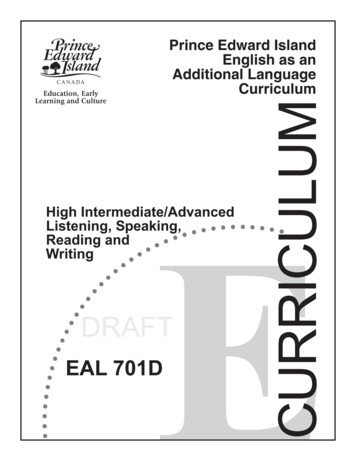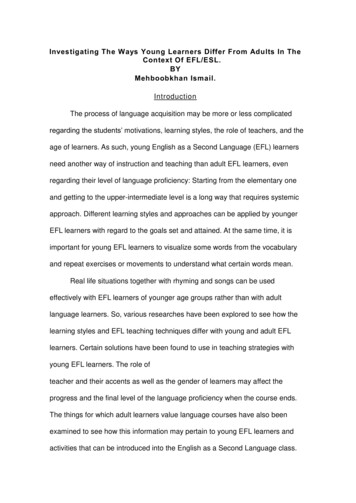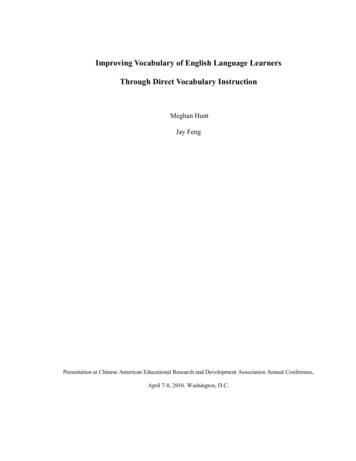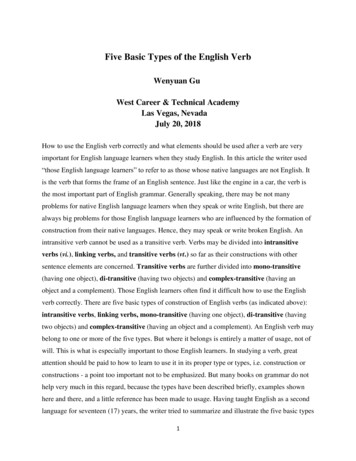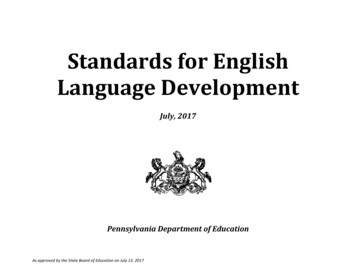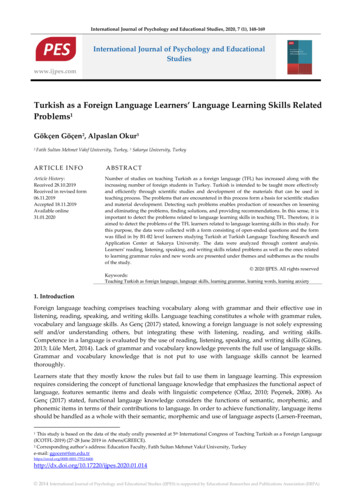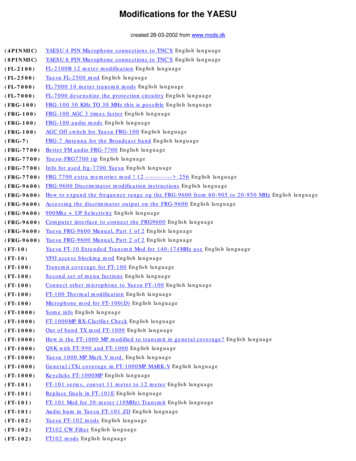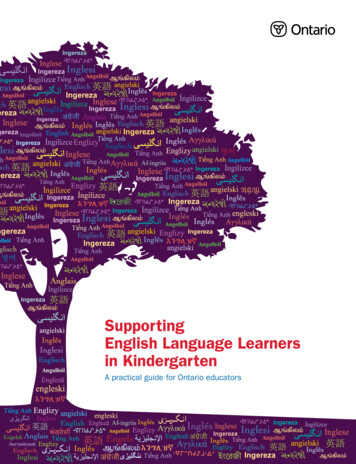
Transcription
lier.SupportingEnglish Language Learnersin KindergartenA practical guide for Ontario educators
Table of ContentsIntroduction31Who are English language learners in Kindergarten?52Working with families and communities173Working with English language learners in Kindergarten334Working as a whole school69Resources75
IntroductionMartina is 5 years old. She has just come to Canada with her grandmother, tojoin her mother and two older brothers. Martina and her family speak Czech athome. Martina is usually at home with her grandmother while her mother is atwork. She loves to listen to her grandmother tell stories of what her life was likeas a child.Shivam is also 5 years old and was born in Ontario. He lives with his parentsand his sister, who is in Grade 3. The family speaks Punjabi in the home andmaintains close ties with their cultural community.Shivam and Martina are eager and excited to start Kindergarten. However, theyare both worried that they won’t always understand the teacher and they won’thave any friends.Martina and Shivam are only two of many children from diverse linguistic andcultural backgrounds – born overseas or here in Canada – who are beginningKindergarten. For all children, starting Kindergarten is a time of major transitionfor both the children and their families. For children like Martina and Shivam,beginning school is not only about adjusting to school and its routines, but alsoabout doing so in a largely unfamiliar language.Kindergarten teachers are asking how best to meet the needs of these Englishlanguage learners (ELLs) – both those born in Canada and those arriving fromother countries. What can we do in our classrooms to create an environment inwhich children of varied cultures and languages thrive and grow? How can weincrease our own knowledge, awareness, and teaching practice to appropriatelysupport the children’s ongoing learning needs? How can we value and respectthe experiences of all children?This document is a resource and tool for teachers, administrators, and otherschool staff as they support ELLs in achieving the overall expectations of theKindergarten program. It will help them provide a quality beginning schoolexperience for ELLs.In preparing this resource, the Ministry of Education acknowledges the valuablework being done in schools and classrooms across Ontario, and the dedicationof teachers throughout the province in creating an inclusive learning environmentthat supports the success of every student.In this document, parent(s) is used to mean parent(s) and guardian(s).
1Who are English languagelearners in Kindergarten?The Kindergarten Program, 2006 (Revised) affirms that early learningexperiences have a profound effect on development (p. 1) and thatchildren develop their knowledge by building on their past experiencesand the learning they have already acquired (p. 2). These pointsapply equally to ELLs. It may be challenging for the teacher to get toknow what those past experiences/learning have been and what theycontinue to be within the children’s homes and communities. Theimportance of building on children’s prior experiences/learning cannotbe overestimated since their identities are involved.The differences that [ELL] children bring to classrooms are notsimply individual differences or idiosyncrasies. They are far toopatterned to be written off as individual differences. They are productsand constructions of the complex and diverse social learnings from thecultures where children grow, live and interact. These cultures are notjust “traditional” cultures we affiliate with ethnic groups or nationalorigins, but they are best described in terms of the community culturesand sub-cultures where children are socialized. These too are dynamicand hybrid – mixing, matching and blending traditional values andbeliefs, children rearing practices and literacy events with those of new,post-modern popular cultures.Eve Gregory, ed., One Child, Many Worlds (New York: Teachers College Press, 1997)
Definition of English language learnersEnglish language learners are students in provincially funded English languageschools whose first language is a language other than English, or is a varietyof English1 that is significantly different from the variety used for instruction inOntario’s schools, and who may require focused educational supports to assistthem in attaining proficiency in English.These students may be Canadian-born or recently arrived from other countries.They come from diverse backgrounds and school experiences, and have a widevariety of strengths and needs.Canadian-born English language learnersMany English language learners were born in Canada and raised in familiesor communities in which languages other than English are spoken. They mayinclude, for example: Aboriginal students whose first language is a language other than English; 2 children who were born in communities that have maintained a distinctcultural and linguistic tradition, who have a first language that is not English,and who attend English language schools; 3 and children who were born in immigrant communities in which languages otherthan English are primarily spoken.English is an international language, and many varieties of English – sometimes referred to as dialects – are spokenaround the world. Standard English is the variety of English that is used as the language of education, law, andgovernment in English-speaking countries. Some varieties of English are very different – not only in pronunciation oraccent but also in vocabulary and sentence structure – from the English required for success in Ontario schools. Somevarieties are so different from standard English that many linguists consider them to be languages in their own right.1The Ministry of Education is dedicated to excellence in public education for all students, including First Nation, Métis,and Inuit students. The document Ontario First Nation, Métis, and Inuit Education Policy Framework, 2007 provides thestrategic policy context within which the Ministry of Education, school boards, and schools will work together to improve theacademic achievement of First Nation, Métis, and Inuit students. The framework has two components: targeted strategiesand supports for First Nation, Métis, and Inuit students; and strategies to increase knowledge and awareness of Aboriginalhistories, cultures, and perspectives among all students, teachers, and school board staff. In order to achieve these goals,a holistic approach integrating the framework strategies throughout all programs, services, and initiatives is necessary.2Section 23 of the Canadian Charter of Rights and Freedoms defines the right of Canadian citizens of the Englishspeaking or French-speaking minority of a province to educate their children in that minority language, wherever numberswarrant. In Ontario, francophone children who come within the defined classes, and who are otherwise qualified to beresident pupils, have the right to be educated in French language schools at both the elementary and secondary levels.For more detailed information, please refer to Aménagement linguistique – A Policy for Ontario’s French-Language Schoolsand Francophone Community (2004).36Supporting English Language Learners in Kindergarten
Section 1 Who are English language learners in Kindergarten?Newcomers from other countriesNewcomers4 arrive from countries around the world at various stages in theireducational careers. They may arrive in their pre-school years or at any pointbetween Kindergarten and Grade 12. They may arrive at the beginning of theschool year or at any time during the school year. Depending on their age andcountry of origin, they may have had varying educational experiences prior to theirarrival in Canada, and consequently will require different levels of support in orderto succeed in the classroom. Newcomers from other countries may include: children who have arrived in Canada with their families as part of a voluntary,planned immigration process. If they are of school age, they have most oftenreceived formal education in their home countries, and some may havestudied English as a foreign language. However, some of these students mayhave had limited or inconsistent access to schooling; children who have arrived in Canada as a result of a war or other crisis intheir home country, and who may have left their homeland under conditions ofextreme urgency. These children have often suffered traumatic experiences,and may also be separated from family members. They may have been intransit for a number of years, or may not have had access to formal educationin their home country or while in transit.English Language Learners ESL and ELD Programs and Services: Policies and Procedures forOntario Elementary and Secondary Schools,Kindergarten to Grade 12, 2007, p. 8-9Children of parents who do not meet Section 23 criteria can be admitted to Ontario’s French language schools by anadmissions committee. Though they may be from any background, they are often the children of parents who have settledin Canada as immigrants or refugees, and for whom French is their first, second, or even third language, yet who feel acertain attachment to French. They often come from countries where the language of public administration or schoolingis French.4Supporting English Language Learners in Kindergarten7
Understanding the importance of first languagesLinguistic and culturaldiversity is an asset,not a deficit, foryoung children.National Associationfor the Education ofYoung Children,Many Languages,Many Cultures:Respecting andResponding to Diversity(Washington, DC: Author,2005)A major component of previous learning involves children’s first languages.Many, including some parents, think that the best course of action when childrenare faced with attending school that is taught in English and with living in asociety where English is the dominant language is to abandon all use of thefirst language and focus entirely on English. However, a solid body of researchindicates that this is not the best way to proceed. Children’s first languagesare closely tied to their identity, and encouraging ongoing development of firstlanguage eases the social and emotional transition that occurs when childrenbegin school. At the same time, students who have a strong foundation intheir first language are likely to learn English more quickly and achieve greatersuccess at school.Fred Genesee, ed., Educating Second Language Children: The Whole Child,The Whole Curriculum, 1994Because of the diversity of language backgrounds in Ontario schools, it isimportant for the school and the home to work together to support the continueddevelopment of the first language for a number of reasons. Continued use of the first language allows children to develop age-appropriateworld knowledge and vocabulary without having to wait until they have learnedenough of their second language to engage with such topics. A rich store of knowledge learned in the first language will transfer readily intothe second; for example, it is much easier for children to learn the languagearound “matching” and the ways in which objects match if they can already doso in their first language. Reading and storytelling in the first language – including in languages withnon-alphabetic writing systems – models and strengthens literacy processes. Children who see their previously developed skills acknowledged in schoolare more likely to feel confident and take the risks involved in learning in theirnew environment. They can see English as an addition to their first language,rather than as a substitution for it. Children who have another language learned the important lesson early onthat words are not the things or actions themselves but represent thosethings or actions. Knowing this results in mental flexibility and makes it easierfor children to acquire further languages. All children who continue to develop a strong foundation in their firstlanguage as they learn other languages are well prepared for participating ina global society.8Supporting English Language Learners in Kindergarten
Section 1 Who are English language learners in Kindergarten?Developing English language skillsSome children who come from homes where another language or variety ofEnglish is regularly used may be indistinguishable in English language proficiencyfrom children of the same age who have only heard and learned English. Thisis particularly the case with children who have been regularly exposed to twolanguages (one of which is English) from their earliest years. The way theydevelop both languages is largely the same as those brought up in a homewhere only one language (English) is spoken (McLaughlin, Blanchard, andOsanai, 1995). Teachers who have not had an opportunity to get to know thechildren and their parents must take great care when making judgments aboutthe English language proficiency of these children.Children appropriately identified as English language learners are likely to have astrong grasp of their first language on entry to Kindergarten. If they have recentlyarrived in Canada, they may understand very little or no English. That does notmean that their ability in their first language is lacking in any way; they mayspeak it fluently and may even be able to read and write in that language.Children whose first language is a variety of English other than that used inOntario schools are also acquiring a second language when they enter school.As suggested by the late Jamaican poet and performer Louise Bennett, itis unacceptable to think that varieties of English like Jamaican English are“inferior” or “bad English.”My Aunty Roachy seh dat it bwile her temper an really bex her fi true anytime she hearanybody a style we Jamaican dialec as “corruption of the English language.” For if dat bede case, den dem shoulda call English Language corruption of Norman French an Latinan all dem tarra language what dem seh dat English is derived from. Oonoo hear de wud?“Derived.” English is a derivation but Jamaica Dialec is corruption! What a unfairity!.Louise Bennett, Aunty Roachy Seh (Kingston, Jamaica: Sangster’s Book Stores, 1993)Supporting English Language Learners in Kindergarten9
Language development strategiesKindergarten-aged ELLs use the following strategies as they learn English: using their first language; not speaking (silent period); using headlines and learned phrases; producing more complex structures and vocabulary.Based on the work of Tabors and Snow (1994)Though this is generally the sequence in which children employ these strategies,they are interrelated and are not necessarily developed or used in a strictly linearfashion. A vast range of individual differences will be found, with some childrennot using a particular strategy at all and others staying with the same strategy foran extended period of time. For most children, there is a lot of movement forwardand backward between strategies, depending on how comfortable children feel ina particular setting or how confident they are with the content.The children in the examples that follow are reflective of ELLs in Ontarioclassrooms, both those born in Canada and those who arrived from othercountries.Using first languageThere are two options for children when everyone around them is speaking anotherlanguage: children can communicate in their first language or stop speakingaltogether. For a period of time, many children communicate in their first language. In situations where no one else speaks/understands the language, thisusually leads to children giving up after they realize that their attempts tomake themselves understood have been unsuccessful. In situations where several children speak the same first language, they willquickly identify who they can rely on as conversation partners and who theycannot.In the classroom Soon after Nazir arrived in his new Kindergarten classroom, he took a bananafrom the snack table and asked the teacher to peel it. He handed it to her andsaid something in his first language. The teacher asked, Would you like me topeel this? (using a gesture to show a peeling action). Nazir shook his head yes.Because he was successful in having this request met, over the next coupleof weeks, Nazir continued to approach the teacher using his first language. Hestopped speaking when he realized that he and the teacher spoke a differentlanguage and she was being rather slow at learning his!10Supporting English Language Learners in Kindergarten
Section 1 Who are English language learners in Kindergarten?Teachers can respond positively to children’s attempts; respond by affirming the children’s attempts to communicate; respond using a combination of gestures, words, and tone of voice; speak with families to learn a couple words in the children’s first language; display and highlight writing in a variety of languages.Silent periodChildren who abandon their efforts to communicate in their first languageoften go through a period where they do not speak at all. These children maybe actively observing, listening, learning, and communicating using non-verbalstrategies. They may be whispering or speaking in a quiet tone, repeating whatother children or adults are saying, as they explore the sounds of the newlanguage. They may also be imitating reading and writing behaviours modelled bythe teacher.In the classroom Sophia spent the first few weeks of learning centre time standing near thewater table then, tugging on the teacher’s shirt and pointing to the water table,she began exploring the water table materials. The teacher knew that it wasimportant to support Sophia’s attempts at trying out her new language in a safecontext. The teacher asked Sophia where she would like to go at learning centretime, and expected Sophia to point and say, water table.Teachers can use movement, music, and visual representation; observe children’s physical movements (e.g., standing close to somethingthey may want); provide hands-on manipulative experiences; have concrete objects available for children to hold and explore (e.g., snow,when engaged in an inquiry about snow); have children point to picture symbols to express their needs; invite children to participate by pointing to familiar objects in sharedreading texts.Supporting English Language Learners in Kindergarten11The time spent in this“silent period” variesamong children.
Using headlines and learned phrasesWhen children are ready to “go public” with their new language, they begin todemonstrate new strategies for communicating that are characterized by theiruse of speech that sounds like headlines or short learned phrases.Headline (often referred to as telegraphic) speech is a typical part of veryyoung children’s development of their first language. It involves using a fewcontent words to communicate an entire idea, and it often focuses on thenaming of objects.Learned phrases (often referred to as formulaic speech) refers to the children’suse of phrases they have heard and tend to use before they fully understandthe meaning of the phrases and before they can use the individual words of thephrase in other utterances.In the classroom When Bojan was building with blocks, his teacher said, Tell me about yourbuilding. Bojan said, House. The teacher said, Bojan, you’re building a house.While David was drawing a picture on the whiteboard, he put the whiteboardclose to the teacher’s face. The teacher said, Tell me about your picture.David pointed to the two people he drew. The teacher repeated the statement.David said, Dad, me.When Julia arrived at Kindergarten registration, she smiled at the officeassistant and said in a quick sequence, How you are See ya later.While Samson was baking bread with the teacher and a small group of children,he took the measuring cup and said in a questioning tone I do that?Teachers can use movement, music, and visual representation; model (e.g., demonstrate a counting strategy, point to words in text while reading); think aloud (e.g., I’m going to start the reading here, while using a pointer toshow where the reading starts); use gestures (e.g., You put the block on the bottom, clearly pointing to theblock on the bottom); identify the child’s actions (e.g., You painted a picture, you jumped, you werecounting the animals); affirm the child’s attempt to communicate (e.g., Yes, that does say your name); extend the communication (e.g., If the child says, I making cake, say, You aremaking cake. Is it chocolate cake?); introduce new vocabulary (e.g., The boy in the book was scared of the dark).12Supporting English Language Learners in Kindergarten
Section 1 Who are English language learners in Kindergarten?Producing more complex languageIn a supportive and inclusive environment, children begin to use more complexEnglish.Early strategies can include: using a mix of first language and English to converse with other children; asking simple questions; joining in with familiar songs, rhymes, and poems; using first language with peers who speak the same first language to clarifyinstructions; responding to basic question words like who, what, where, and when; communicating observations after teacher modelling (e.g., Our tower is 10blocks high); knowing and following directionality in text.As children continue to produce more complex English, they begin to rely lesson learned phrases and begin to rehearse, apply, and gain control over syntacticstructures.Later strategies can include: retelling personal experiences using simple sentence patterns and familiarvocabulary; representing personal experiences through paintings and drawings; beginning to describe their thinking in conversations with teachers andother children; following directions related to familiar routines;participating in whole- and small-group activities and social situations;naming some letters in upper and lower case;making suggestions in small groups when problem solving;contributing to shared writing experiences;experimenting with present and past verb tenses (e.g., What you doing?I done that.); speaking with clarity and fluency approaching the pace of first language peers.In the classroom Iva was at the writing centre with another child who spoke the same firstlanguage. The teacher observed the two speaking their first language with eachother. She also heard some English phrases (e.g., Iva asked, I use marker?)Supporting English Language Learners in Kindergarten13
During music and movement experiences, Ayla followed along with the actionsand sang familiar songs, demonstrating her productive language strategies. Inother large-group activities such as Shared Reading or Shared Writing, Ayla wasnot yet orally participating. Knowing that sometimes children first attempt theirnew language during music activities, the teacher planned music every day.The teacher planned a small-group shared reading lesson with Jasmin, Nikos,and Kim, and modelled the reading strategy of using illustrations to predict andconfirm unknown words. Looking at the picture in the book helped Nikos readblack cat and yellow duck.Teachers can affirm the child’s attempt to communicate (e.g., That was good thinking; I likethe way you described this part of your picture); use gestures (e.g., How tall do you think your plant is? while moving the child’shand along the plant); use movement, music, and visual representations; label children’s actions and extend language (e.g., If the child says, I making acake, say, Could you make three cakes that I can pick up after work?); introduce new or specialized vocabulary (e.g., That is your shadow); model (e.g., demonstrate using illustrations to read unknown words); think aloud (e.g., make connections by saying, When I read this part, it mademe think about the park near my house and how the leaves crunch when I walkon them); plan and implement small-group shared reading, using multiple copies of thesame text; plan and implement small-group discussion, using a wordless book, a familiarobject, or something the child has drawn or constructed.What might I expect to see and hear asEnglish language learners are learning English?It is important for all people who work with Kindergarten children to recognizethat language mixing or code-switching are common strategies used bychildren learning a second language. It will take children a while to separatethe languages they hear around them and to use each of those languages inappropriate circumstances. In the meantime, they use what they know anddemonstrate an eagerness to communicate by doing so. This also applies tochildren who come to school speaking a variety of English, although it is likelythat they have heard their parents code-switch between dialect and standardEnglish and already have a receptive understanding of the language of school.14Supporting English Language Learners in Kindergarten
Section 1 Who are English language learners in Kindergarten?There is much variation in how long it takes ELLs to develop age-appropriateEnglish language proficiency. Many factors come into play, such as how muchEnglish children know on entry to Kindergarten, how strong their first languageskills are, and how comfortable and engaged they feel in the Kindergartenenvironment. Even before they begin to produce English, however, they areworking diligently on their English skills. Some children will not speak muchuntil they can speak well; others will use whatever English or other languagethey know, and add whatever gestures they need, in order to join in the activitiesof the classroom almost from Day 1. Whatever combination of strategies theyemploy, these children will develop English skills. With the school and the homeworking together, the children’s first language will also continue to develop duringthis time.Teacher Reflection When I think back to when I first met the ELLs in my class,I marvel at how much progress they have made in such a short time. It never ceases toamaze me how the children are able to navigate their way through so much new learning.I have learned so much from working with ELLs and their families.ELLs in Kindergarten with possibleSpecial Education needsIt is important to recognize that ELLs will demonstrate exceptionalities (including giftedness)in similar proportions to the general population. However, it is often difficult to determinethe nature of ELLs’ exceptionality before they are fully fluent in English. Characteristics oflearning a second language may mimic characteristics of some learning exceptionalities.For example, a child who can focus on instruction only for a short period of time may raisea question about a possible special education need, but for an ELL it may be indicativeof a lack of comprehension or exhaustion from trying to work out what is being meant.For further information, see Ontario Ministry of Education, The Kindergarten Program, 2006(Revised), pp. 25–26.Supporting English Language Learners in Kindergarten15
21Working with familiesand communitiesChildren’s first language, culture, and personal identity are inextricablylinked. The positive development of each child requires maintainingclose ties to the child’s family and community. When schools respectand value a child’s first language and culture, children, families, andcommunities stay securely connected. If children and their parents feelthat their previously acquired language, background knowledge, andculture are not valued, children’s sense of identity and self-worthcan be negatively impacted. However, when schools capitalize on therichness of the culture (e.g., experiences, understandings, values, andlanguage) that children bring to the classroom, children’s learning andsense of belonging are enhanced.A welcoming and inclusive multicultural school is one in which studentsand parents of all linguistic and cultural backgrounds feel welcome,valued, and included.(Coelho, 2004)
Role of parentsThe Kindergarten Program acknowledges that children perform better in schoolif their parents are involved in their education (p. 3). Parents provide a wealthof family tradition, knowledge, and experience for their children. They are theirchildren’s first teachers; this role continues when the children enter school.Building relationships with the homeSchool staff can lay the groundwork for ensuring that communication with thehome is handled in an honest, sensitive, and respectful manner. Communicationwith parents who are ELLs themselves requires some thoughtful planning.InteractionNew Teacher:How do you begin to communicate with children’s families when you don’tspeak the same language?Mentor:A good starting point for me is to think about how I would want to be treatedif I were a parent in a new country talking to my child’s teacher. I’d like thatteacher to recognize the important role I play in my child’s education and toshow empathy for me as a newcomer.Providing an interpreter would help me communicate more complex ideas thanI could if I had to struggle to express myself in the language I was just learning.Inevitably, there will be some challenges along the way, but the key is to learnfrom them and move on. For example, I found it natural to hold out my handto shake parents’ hands, and sometimes they would not return the gesture.Reflecting on those uncomfortable moments helped me learn what to do nexttime. In some parents’ cultural tradition, shaking hands with a teacher did notfeel appropriate. So now I wait for the parents to offer their hands first or, if Iforget because it comes so naturally to me, I just pull back my hand and say,“Good morning, I am your son’s teacher.”New Teacher:I know it is important to find out about the families’ backgrounds, so whathave you done to find out more?Mentor:I have tried different things as this is something I am learning too. I have saidthings such as, I
6 Supporting English Language Learners in Kindergarten Defi nition of English language learners English language learners are students in provincially funded English language schools whose fi rst language is a language other than English, or is a variety of English1 that is signifi cantly different from the variety used for instruction in
